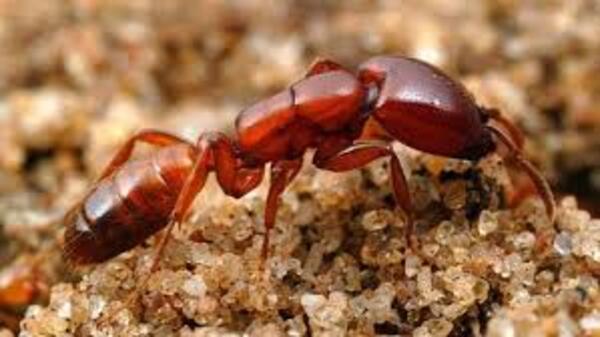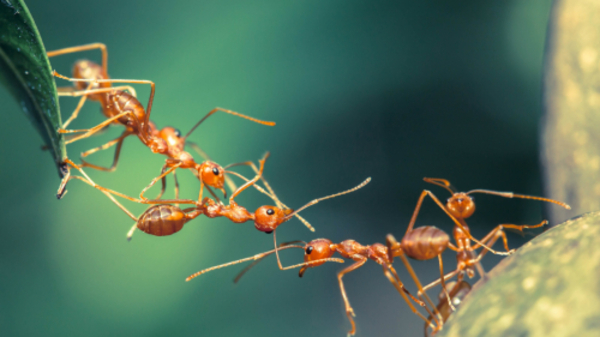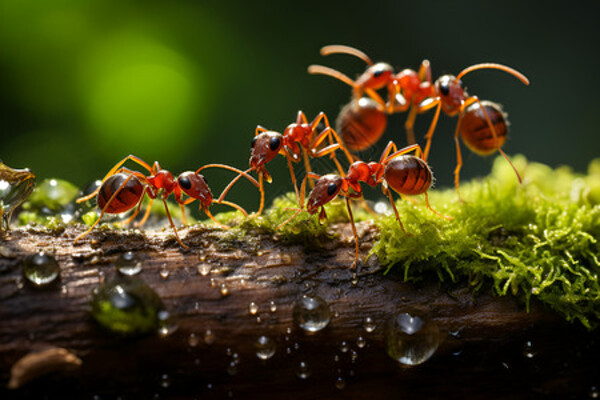Cannibal ants might sound like something straight out of a horror movie, but they're very real—and incredibly fascinating. These ants, known for sometimes eating their own colony members, exhibit complex behaviors that can be surprising to those of us more familiar with their industrious, cooperative side. Why do these ants turn to cannibalism? The reasons are varied and range from survival strategies in times of hardship to maintaining colony health by eliminating weaker members. Let’s dive into the world of cannibal ants facts that shed light on these tiny, yet fierce, creatures.

Cannibal ants are some of nature’s most efficient survivalists. Although their behaviors might seem morbid, they play a crucial role in their colonies' ability to endure harsh environments. Here are some fascinating facts about their grim survival tactics:
Cannibalism for Survival: When food is scarce, some ant species resort to eating their fellow colony members as a last-ditch effort to survive.
Larvae as a Food Source: In extreme situations, worker ants will consume their own larvae and pupae to feed the rest of the colony, particularly the queen.
Self-Sacrificing Workers: In some colonies, workers willingly offer themselves as food, prioritizing the survival of the queen and larvae over their own.
Ant Wars: When colonies engage in territorial disputes, the victors may feast on the defeated ants, turning a fight for land into a feast for survival.
Nutrient Recycling: Cannibalism helps recycle valuable nutrients, ensuring that no resources within the colony go to waste.
Some ant species are more prone to cannibalism than others, with a few well-known ones leading the pack:
Army Ants: Famous for their aggressive, nomadic lifestyle, army ants will readily eat dead or injured colony members, especially during long migrations.
Fire Ants: Known for their painful sting, fire ants turn cannibalistic during food shortages, consuming weaker members to ensure colony survival.
Carpenter Ants: In stressful conditions, such as when they are trapped or isolated, carpenter ants sometimes resort to eating their fellow ants.
Weaver Ants: Renowned for their intricate nest-building skills, these ants will cannibalize colony members to keep the colony’s health in check.
Leafcutter Ants: Typically known for farming fungus, leafcutter ants may cannibalize their own larvae during extreme food shortages.
Cannibalism serves a variety of important functions within ant colonies, often ensuring that the strongest survive and that colony health is maintained.
Disease Control: Ants eat sick or dead members of the colony to prevent the spread of disease.
Population Control: Cannibalism can help regulate the colony’s population, ensuring it doesn’t outgrow available resources.
Energy Conservation: By consuming fellow colony members, ants conserve energy that would otherwise be spent searching for food.
Queen’s Survival: The colony’s survival depends on the queen, so cannibalism often ensures that she receives the nutrients needed to thrive.
Colony Relocation: When ants relocate to a new habitat, they may eat weaker members to reduce the burden on the colony during travel.
Cannibalism has a profound effect on ant behavior, influencing how colonies function and interact with one another.
Feeding Hierarchy: In times of famine, higher-ranking ants often feed on lower-ranking ones, keeping the colony's most crucial members alive.
Aggression Levels: Cannibalistic ant species tend to exhibit higher levels of aggression and are more territorial compared to non-cannibalistic species.
Foraging Patterns: Cannibalistic colonies may forage less and rely more on internal resources, such as weaker members of the colony.
Nest Defense: By removing weak or injured members, cannibalism strengthens the colony, making it more resilient to outside threats.
Social Bonds: Although it seems counterintuitive, cannibalism can reinforce social cohesion by ensuring that only the strongest members survive to lead the colony.
Environmental factors play a significant role in triggering cannibalistic behavior in ants. Here are some key conditions that may lead ants to eat each other:
Food Scarcity: The primary trigger for cannibalism is a lack of food, forcing ants to turn inward for sustenance.
Habitat Destruction: When their habitat is destroyed, ants may resort to cannibalism as a survival mechanism.
Climate Change: Extreme weather conditions can disrupt food supplies, prompting ants to eat their own colony members.
Predator Pressure: When predators are abundant, ants may turn to cannibalism to reduce the colony’s vulnerability.
Human Activity: Urbanization and deforestation have led to habitat loss, making cannibalism more common among ants as they struggle to survive.
Cannibalism can occur at various stages of an ant’s lifecycle, from eggs to adulthood:
Egg Stage: During times of desperation, ants may eat their own eggs to avoid starvation.
Larval Stage: Larvae are often the first to be sacrificed during food shortages due to their high nutritional value.
Pupal Stage: Similarly, pupae are nutrient-dense and may be eaten by the workers in hard times.
Adult Stage: Injured or weak adult ants are prime candidates for cannibalism, allowing the colony to conserve resources.
Queen Stage: In very rare cases, a failing queen may be cannibalized to make room for a stronger successor.
Cannibalism has shaped the evolution of ants in surprising ways, influencing their survival strategies and social structures:
Adaptive Behavior: Cannibalism is an adaptive behavior that has enabled ants to survive in even the harshest environments.
Genetic Diversity: By eliminating weaker members, ants may improve the genetic strength of the colony over time.
Survival Mechanism: Cannibalism is a survival mechanism that has evolved over millions of years, helping ants thrive in resource-scarce environments.
Natural Selection: In some cases, cannibalism is favored by natural selection, ensuring that the fittest members of the colony survive and reproduce.
Evolutionary Advantage: This behavior can provide a clear evolutionary advantage by making sure that a colony’s strongest members are the ones who survive and reproduce.
Cannibal ants are not just grim creatures that eat their own—they are a testament to nature’s resilience and adaptability. Through their cannibalistic tendencies, these ants ensure the survival of their colony, recycling nutrients and maintaining health. It’s a fascinating, if somewhat unsettling, glimpse into the complexity of their social structures and survival strategies.
Understanding these behaviors gives us a new appreciation for the intricacies of the natural world. So, next time you see an ant, remember: there’s a lot more to their world than meets the eye. Nature’s wonders are endless, and cannibal ants are just one example of its fascinating, and sometimes gruesome, diversity.

The idea of man-eating ants may sound like something out of a nightmare, but the truth is both less terrifying and more fascinating. While no known species of ants can actively hunt and devour humans or large animals, some ant species do exhibit aggressive and potentially dangerous behaviors. So, could ants ever be a threat to humans or other large creatures? Let’s dive deeper to understand the reality behind these so-called “man-eating” ants.
Army ants, especially species like Eciton burchellii in Central and South America and Dorylus in Africa (also known as driver ants), are often considered the most fearsome. They don’t have permanent nests and are always on the move in massive swarms, consuming anything in their path, from insects to small animals.
While army ants can kill small animals by sheer numbers, it’s important to understand that these ants work in large colonies, sometimes containing up to a million individuals. They rely on overwhelming their prey rather than attacking something large like a human. For humans or large animals, army ants would likely be more of a nuisance than a deadly threat. However, they can cause real harm to immobilized or weak animals, as these ants can bite in large numbers and cause severe pain or injury.
In some rare cases, driver ants in Africa have been known to attack immobilized animals like cows or goats, especially when they’re weak, sick, or tied up. The ants swarm in such large numbers that they can suffocate or overwhelm their prey by biting and tearing at flesh. Stories of people, particularly infants or the elderly, being attacked by these ants exist, but such cases are extremely rare, and usually happen when the victim is unable to escape the swarm.
Despite their fearsome reputation, no ant species is capable of actively hunting down and eating a healthy human. Even aggressive ants like army ants would not see a human as prey. Most ants are scavengers, and while they can feed on dead animals, including large creatures, the idea of ants consuming a human alive is largely a myth.
However, there are situations where ants might scavenge a dead body, given enough time. In hot, tropical environments, ants can play a role in decomposition, but they’re not likely to be the main cause of death.
Ants are incredibly efficient when it comes to cleaning up dead animals. Species like fire ants and army ants will quickly consume smaller creatures like rodents, birds, or reptiles if they come across a carcass. Ants are well-known for stripping down an animal to its bones, but this happens only if the animal is already dead or dying. It’s important to note that ants don't target large animals for hunting; they are opportunistic feeders.
While ants cannot physically devour a human, certain ants, like fire ants, can pose a real threat due to their painful and venomous stings. Fire ant stings can cause severe allergic reactions, which in extreme cases, may lead to anaphylaxis, a life-threatening condition. In some parts of the world, fire ants are a dangerous invasive species, and their aggressive swarming behavior makes them a real threat to people who unknowingly disturb their nests.
The idea of ants devouring humans or large animals alive is mostly the stuff of urban legends and horror stories. While ants, especially army or driver ants, can be aggressive and cause harm in large numbers, they don’t actively hunt large creatures. The real danger lies in allergic reactions to ant stings and the sheer overwhelming numbers that some ant species use to overwhelm smaller prey or scavenge already dead animals.
In summary, ants are incredible survivors and can clean up animal remains very efficiently, but their role as "man-eaters" is highly exaggerated. For most of us, ants are more of a nuisance than a real threat.

Ants are some of the most fascinating creatures on Earth, and among them, certain species stand out for their extraordinary strength, aggressive behavior, and unique defense mechanisms. Let’s explore the four most powerful ant species: army ants, so-called "man-eating" ants, exploding ants, and bullet ants.
Army ants are well-known for their massive, nomadic colonies and aggressive hunting techniques. These ants don't build permanent nests but form temporary bivouacs, moving in enormous swarms that can contain up to a million individuals.
Species: The most famous species are Eciton burchellii (found in Central and South America) and Dorylus (driver ants, found in Africa).
Power: Their power lies in their collective behavior. Army ants attack in large numbers, overwhelming their prey by sheer force. They can kill small animals, insects, and sometimes even immobilized larger animals by swarming over them.
Notable Behavior: Army ants exhibit coordinated hunting strategies, with soldiers protecting the colony while workers hunt and dismember prey. Though their reputation is fearsome, they are unlikely to threaten healthy humans or large animals unless trapped or immobilized.
The term "man-eating ants" often refers to aggressive ant species like driver ants or army ants, especially in African and South American jungles. While these ants can be dangerous, especially in large swarms, the idea that they actively hunt and eat humans is largely exaggerated.
Species: Driver ants (Dorylus) in Africa are often called "man-eaters" because of their aggressive nature.
Power: These ants are capable of attacking and killing small or weak animals, and in rare cases, they have been known to attack people who are immobile or incapacitated. The real danger comes from their massive numbers, as they bite fiercely and can quickly overwhelm.
Notable Behavior: These ants forage in massive raids, devouring anything in their path, including insects, reptiles, and small mammals. The idea of them consuming humans comes from rare stories where people, especially children, have been attacked when they could not escape the swarm.
Exploding ants (Colobopsis explodens) are one of the most bizarre and powerful ant species in terms of defense. These ants are found in Southeast Asia and have a unique way of protecting their colony — by self-destruction.
Species: Colobopsis explodens.
Power: These ants have a specialized defense mechanism where workers rupture their own bodies when threatened, releasing a toxic, sticky substance that immobilizes or kills enemies. This extreme form of self-sacrifice is both effective and deadly.
Notable Behavior: The "explosion" is a last-ditch effort to defend the colony from predators like larger insects. By bursting themselves, these ants ensure that their enemies are neutralized, even at the cost of their own lives.
The bullet ant (Paraponera clavata) is notorious for having the most painful sting of any insect on Earth. Found in the rainforests of Central and South America, this ant's sting is said to feel like being shot, giving it the name "bullet ant."
Species: Paraponera clavata.
Power: Its power lies in its incredibly potent sting, which injects a neurotoxin known as poneratoxin. This toxin causes intense pain that can last for up to 24 hours. While not deadly, the sting is excruciating and can incapacitate even large animals for short periods.
Notable Behavior: Bullet ants are solitary hunters, and while they do not attack in swarms like army ants, a single sting is enough to deter most predators. They are often used in initiation rituals by some indigenous tribes, where participants must endure multiple stings as a test of endurance and bravery.
Each of these four powerful ant species — army ants, man-eating ants, exploding ants, and bullet ants — demonstrates the incredible diversity and strength of ants. Whether through overwhelming numbers, extreme aggression, self-sacrifice, or unbearable pain, these ants have earned their place as some of the most formidable insects in the animal kingdom.
While none of these ants are capable of actively hunting and devouring humans, their strength and unique survival strategies make them both fascinating and formidable creatures to respect.

Ants are one of the most persistent pests that can invade homes, gardens, and commercial spaces. Successfully managing an ant infestation requires a combination of methods that target the colony, prevent future infestations, and address environmental factors. Here’s a comprehensive guide to ant control methods.
The first step in effective ant control is identifying the species you're dealing with. Different ants require different treatments. Common household ant species include:
Carpenter Ants: Can damage wooden structures.
Odorous House Ants: Known for their rotten coconut smell when crushed.
Pavement Ants: Typically found in cracks in pavement.
Fire Ants: Aggressive ants with painful stings.
Argentine Ants: Common household invaders that form large colonies.
Knowing the species will help determine the best treatment approach.
Ants enter homes in search of food. Removing their food supply is crucial for discouraging them from coming back.
Clean Up Spills: Wipe up any food or liquid spills immediately, especially sugary or greasy substances.
Store Food Properly: Keep food in sealed containers. Ensure that pet food is also stored securely.
Take Out Trash: Regularly empty trash bins and use tightly sealed lids to avoid attracting ants.
Clean Surfaces: Clean countertops, floors, and tables after meals, as crumbs can attract ants.
Ants can enter through tiny cracks and crevices. Sealing these entry points can prevent ants from gaining access to your home.
Seal Cracks and Gaps: Use caulk to seal cracks in walls, doors, windows, and foundations.
Install Door Sweeps: Install door sweeps on exterior doors to block ants.
Check Vents and Pipes: Ensure that vents, pipes, and utility lines are sealed to prevent ants from entering through these spaces.
Baiting is one of the most effective ant control methods because it targets the entire colony, including the queen.
Ant Baits: Place bait stations along ant trails where ants are foraging. The ants will take the bait back to the nest, eventually killing the colony.
Types of Baits: Use slow-acting baits (usually containing boric acid or hydramethylnon), as ants will carry it back to their nest, ensuring widespread exposure.
Placement: Place baits near entry points, under sinks, along baseboards, and in areas where ants are active.
There are several non-toxic, natural remedies that can help deter ants without the use of harsh chemicals.
Vinegar Solution: Mix equal parts water and white vinegar in a spray bottle and spray ant trails. The strong smell disrupts their scent trails.
Lemon Juice: Spray lemon juice on ant entry points; its acidity confuses ants and deters them.
Diatomaceous Earth: Sprinkle food-grade diatomaceous earth around entry points. This powder dehydrates ants when they come into contact with it.
Cinnamon and Peppermint Oil: Sprinkle cinnamon or spray diluted peppermint oil along entry points to repel ants. These scents are natural deterrents.
Boric Acid and Sugar: Mix boric acid with sugar to make a natural bait. Place it in areas where ants are present.
For more severe infestations, chemical insecticides may be necessary to achieve ant control.
Insecticide Sprays: Use non-repellent insecticide sprays around entry points, baseboards, and areas of heavy ant traffic.
Granular Insecticides: These can be spread around the perimeter of your home or garden to kill ants before they enter.
Ant Dust: Apply ant dust in wall voids, cracks, or entry points. When ants walk through the dust, it clings to their bodies and spreads to the colony.
Professional-Grade Insecticides: If over-the-counter insecticides are ineffective, consult a pest control professional to apply stronger, professional-grade treatments.
Some species, like carpenter ants, may require direct treatment of their nests.
Locate the Nest: Follow the ant trails to locate the nest, which may be inside walls, in wood structures, or outside in the soil.
Direct Application: Apply insecticide dust or foam directly to the nest to eliminate the colony.
Carpenter Ants: For carpenter ants, drill small holes into wood structures and apply insecticidal dust into the galleries to kill the ants inside.
If ants are entering your home from the outside, it’s essential to manage outdoor colonies.
Remove Outdoor Food Sources: Clear away any food scraps or pet food in the yard.
Trim Vegetation: Keep shrubs, trees, and plants trimmed and away from your home’s exterior, as they can provide ants with easy access.
Create a Barrier: Apply granular or liquid ant insecticides around the perimeter of your home to create a protective barrier.
Treat Outdoor Nests: If you find an outdoor ant nest, apply an appropriate insecticide directly to the mound to eliminate the colony.
After applying control methods, monitor the area for any remaining ant activity.
Inspect Baits: Check bait stations regularly and replenish them if necessary.
Look for New Trails: Even after treatment, ants may create new trails. Treat new activity promptly to prevent a resurgence.
Reapply as Needed: Depending on the product, some insecticides may need to be reapplied every few months to maintain effectiveness.
If a large or persistent ant infestation remains unmanageable, consider hiring a professional pest control service. Experts have access to more effective tools and products to target ants and can provide long-term solutions.
Benefits of Professionals: They can properly identify ant species, locate hard-to-find nests, and use stronger, more effective treatments.
Maintenance Programs: Many pest control services offer ongoing maintenance plans to prevent future infestations.
Controlling ants requires a combination of preventative measures, natural remedies, baiting, and sometimes chemical treatments. By removing food sources, sealing entry points, and targeting the colony, you can achieve long-lasting results. Regular monitoring and follow-up are essential to ensure the ants do not return. If needed, professional pest control services can provide a more comprehensive solution for large or difficult infestations.
animal tags: ants
We created this article in conjunction with AI technology, then made sure it was fact-checked and edited by a Animals Top editor.